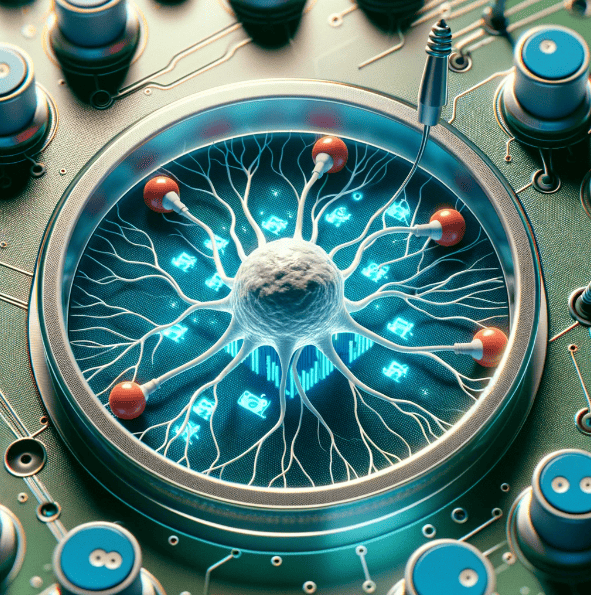You might have heard recently about lab grown brain cells trained to play Pong. I sat down with the founder and CEO of Cortical Labs Hon Weng Chong, for an overview of this world changing work. DishBrain, a system that grows mouse cells and human brain cells derived from stem cells on microelectrode arrays, is an innovative approach to neural network training of goal-directed tasks, like playing the game Pong.
This initiative is moving beyond the conventional boundaries of graphical processing units like those from Nvidia and AMD, which excel in tasks like matrix multiplications and instead is harnessing the computational power of biological neurons.
The project’s approach is not to rely on silicon-based computation rather it utilizes transistors to interpret the electrical activity between neurons, translating it into a language understandable by computers and vice versa. This revolutionary method leverages biological neurons as the fundamental units of computation.
So how does it work?
“Our transistors are not there to compute. Transistors are there to convert the electrical activity between neurons into something a computer can understand and take what the computer says and tries to provide electrical stimulation that the neurons can understand. We’re actually relying on these biological neurons as the computing unit,” said Chong.
The cells in DishBrain exhibit learning and adaptation in the absence of a conventional reward mechanism. Pavlov’s conditioning methodology is one approach to reinforcement learning, but Cortical Labs is taking a different approach. The cells are not motivated by treats and instead, adapt and respond to the electrical stimuli provided by the microelectrode arrays in a way that allows them to engage in goal-directed behavior, such as playing Pong. How? They use a bit of chaos to punish the cells, resulting in a network that tries to minimize unpredictability in their environment. This might explain how learning happens at the organism level, we’re pattern seeking creatures, and predictability leads to survival.
This phenomenon may suggest a more intrinsic form of adaptation and learning at the cellular level, distinct from the reward-based systems we’re familiar with in higher organisms.
In the context of DishBrain, if the neurons failed to interact correctly with the virtual Pong game (i.e., if they failed to hit the ball with their paddle), the system would introduce an unpredictable stimulus for four seconds. This unpredictable stimulus served as a form of ‘punishment’ or a negative signal because it introduced more entropy or disorder into the neurons’ environment, which they are naturally driven to minimize. Successful interaction (hitting the ball) led to a brief, predictable signal before the game continued in a predictable manner.
This predictable signal functioned as a form of ‘reward,’ fostering neuronal connectivity and encouraging the desired behavior. When the neurons failed to interact correctly with the virtual Pong game, resulting in a missed interception of the ball by the paddle, an unpredictable stimulus was delivered at 150mV voltage and 5Hz for 4 seconds. Conversely, when the neurons successfully intercepted the ball, a predictable stimulus was delivered across all electrodes simultaneously at 100Hz for 100ms, briefly interrupting the regular sensory stimulation before the game continued in a predictable manner.
Using this setup, DishBrain learned to play Pong within five minutes.
The neurons adapted their behavior to avoid the disruptive, unpredictable stimuli and seek out the predictable ‘hit’ condition. This learning process is fascinating because it shows that even at a cellular level, without a conventional nervous system or brain as we understand it, neurons can exhibit goal-directed behavior and adapt based on their environmental feedback.
These studies suggest that intelligence or learning, even at the cellular level, may fundamentally involve the drive toward creating or maintaining order, minimizing unpredictability, and maximizing predictability in the environment. This is a profound insight because it extends the concept of adaptive behavior and learning from complex organisms with advanced nervous systems down to individual cells.
The fascinating aspect of this technology is its potential applications across various fields, including personalized medicine and drug discovery. By employing human cells in these computational devices, the team aims to pave new paths in understanding and treating diseases. They envision a future where this technology could revolutionize medical treatments, possibly eliminating the need for organ transplants by enabling the growth and re-injection of organ-specific cells.
This project is not merely about creating a brain-computer interface but about forging a profound understanding of the functionality and potential of human neurons. It opens up possibilities for significant advancements in treating diseases and understanding the intricate workings of the human brain. The team’s work is a testament to the power of interdisciplinary collaboration, combining the realms of computer science, biology, and medicine to explore the vast potentials of human neurons as computational units.
What kind of applications would this potentially be used for?
“By using human cells in this computational device, we can potentially start using this to discover new drugs and more personalized medicine. Now, if we could take your cells and we could then grow them and because they’re genetically identical to you as a host, we can use that as a baseline and then you can perturb that with drugs.”
I’ll leave you with a couple of mind-blowing findings from this research. Cells from people with epilepsy have seizures within the petri dish!! Stem cells taken from the same person learn at different rates!! As the project progresses, it holds the promise of unlocking new realms in medicine and technology, signaling a new era where the fusion of biology and computation can lead to unprecedented innovations and breakthroughs.
Chong has graciously agreed to a longer interview, keep an eye out for a more in-depth discussion in a future pod-cast.


